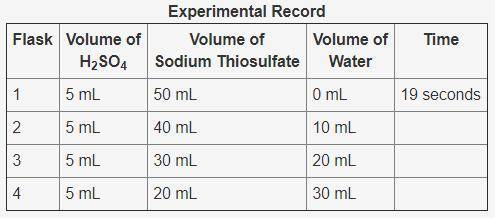
In an experiment, sulfuric acid reacted with different volumes of sodium thiosulfate in water. A yellow precipitate was formed during the reaction. A cross drawn at the base of each flask became gradually invisible due the formation of this yellow precipitate. The time taken for the cross to become invisible was recorded. A partial record of the experiment is shown. [see attachment] Based on your knowledge of factors that affect the rates of chemical reactions, predict the trend in the last column of the experimental record. Use complete sentences to explain the trend you predicted. You do not have to determine exact values for time; just describe the trend you would expect (increase or decrease) and why it occurs.


Answers: 1


Another question on Chemistry

Chemistry, 22.06.2019 07:30
The scheme below is from a series of reactions that are part of a synthesis of vitamin a. answer the following questions with reference to this scheme. (i) what is "reagent a"? (ii) draw a step-by-step mechanism which explains the formation of compound c from compound b (iii) which reagents would you use to form compound e from compounds c and d (reagents b and c)? for each reagent suggested above in (ii) explain the role of the reagent in the reaction to (iv) form compound e. you may wish to do this by drawing a mechanism. 1. addition of reagent a но reagent a 2. н,о" thо oh нон-с compound a. compound b. compound c .ch-оh 1. reagent b "сно 2. reagent c сh oh compound e. compound d.
Answers: 2

Chemistry, 22.06.2019 18:00
How many moles of oxygen gas are produced from the decomposition of six moles of potassium
Answers: 1

Chemistry, 22.06.2019 18:30
Which of the following words describe the reality that the universe looks the same from various perspective
Answers: 3

Chemistry, 23.06.2019 01:30
Some molecular compounds, such as hcl, ionize completely in solution. for molecular compounds such as h2co3, most molecules do not ionize in solution. which describes the properties of these two solutes? a. hcl and h2co3 have the same effect on the properties of the solution. b. hcl raises the freezing point of water more than h2co3 does. c. hcl raises the boiling point of water more than h2co3 does.
Answers: 2
You know the right answer?
In an experiment, sulfuric acid reacted with different volumes of sodium thiosulfate in water. A yel...
Questions


English, 19.01.2021 14:00

Chemistry, 19.01.2021 14:00

Social Studies, 19.01.2021 14:00

Mathematics, 19.01.2021 14:00

English, 19.01.2021 14:00

Biology, 19.01.2021 14:00

History, 19.01.2021 14:00

Mathematics, 19.01.2021 14:00

Chemistry, 19.01.2021 14:00

Mathematics, 19.01.2021 14:00

Mathematics, 19.01.2021 14:00

Mathematics, 19.01.2021 14:00

Mathematics, 19.01.2021 14:00

Mathematics, 19.01.2021 14:00


History, 19.01.2021 14:00

English, 19.01.2021 14:00

Mathematics, 19.01.2021 14:00

History, 19.01.2021 14:00



